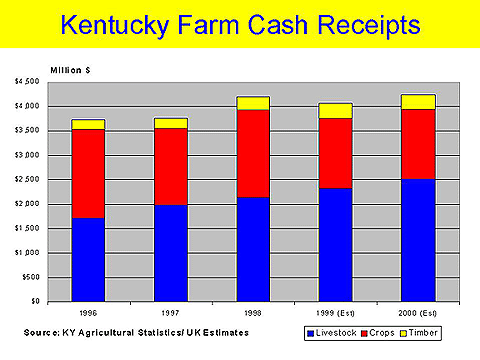Kentucky's Ag Economy In 2000 Influenced by A Variety of Factors
Kentucky's Ag Economy In 2000 Influenced by A Variety of Factors

Kentucky agriculture is not a single, homogeneous industry that will rise or fall in the new millennium because of one or two factors. It is a complex, multifaceted industry whose performance in 2000 will be influenced by many forces, including global production, the import-export market, weather, and U.S. government agriculture policy.
That's the message from several agricultural economists at the University of Kentucky's College of Agriculture. At a recent presentation to ag leaders and news media, the economists said the outlook for Kentucky farmers next year is more favorable or less favorable depending on the type of farm enterprise you have, plus several other key factors. Some of these factors, such as weather, are unpredictable.
"The drought had a big impact on total farm cash receipts for 1999," said Larry Jones, UK Extension economist in agricultural impact. "Total farm cash receipts were more than $300 million lower, due largely to the drought, for a 1999 total of just over four billion dollars. Total cash receipts for 2000 could increase slightly to about four and a quarter billion dollars."
Jones said a decline in this year's net farm income was tempered by a large infusion of government funds, somewhat higher crop insurance payments, and Phase II tobacco payments.
"For 2000 we expect some post-drought recovery in the crop sector, as well as the livestock industry. Timber will remain about the same in terms of cash receipts," Jones said. "A big question for next year is how much, and in what form, government payments will come to the agriculture sector."
For the tobacco sector, cash receipts in 2000 are estimated to decline.
"Unless the burly cooperatives are successful in moving a significant volume of pool stocks, and/or companies significantly boost purchase intentions, burley quotas will decline by more than 20 percent," said Will Snell, Extension specialist for tobacco policy. Snell said excess world burley supplies, cigarette price increases, political and legal uncertainties, and other market factors contributed to reduced demand for burley in 1999.
"The question we're asking for 1999 is will demand even reach the four hundred million-pound mark," said Snell. "The export market is expected to rebound in the near future, but unless we can get some calming of the political and legal environment against tobacco, and the companies to change some of their importing trends, we may not be able to see future demand for U.S. burley tobacco rise back to five hundred million pounds."
Livestock producers should see improved market conditions over 1999, a year many industry observers call "disastrous" due to low prices and drought.
"The year 1999 is a year to forget for most livestock producers," said Lee Meyer, Extension livestock marketing specialist. "For the beef industry, 2000 will likely see continued strength, especially on the feeder cattle side. The hog market is still struggling to get to profitable levels, and pork production will decline perhaps another three percent. Prices are likely to average the break-even price of around the mid-30s. Profitability for hog producers will depend in large part on continued low feed costs, with some of our better pork producers seeing some profit next year." Meyer added that consumer consumption of beef and pork is up, and this is good news for those industries.
The price outlook for corn and soybeans next year will be heavily dependent on world production prospects. Increasing supplies of U.S. corn, soybeans, and wheat do not bode well for stronger prices in 2000, but a major weather development in one of the world's grain producing areas could provide opportunities for U.S. producers.
"As stocks build around the world, prices tend to decline," said Steve Riggins, Extension grain marketing specialist. "However, global stocks of coarse grains and wheat relative to use levels are lower than last year, and quite low by historical standards. Weather shocks around the world could lead to volatility and higher prices."
Riggins said producers who develop and execute marketing plans based on flexibility will increase their chances for reward.
"The current situation of building stocks and low prices -- and the possibility of more of the same in 2000 -- make it necessary for grain farmers to have a marketing plan," said Riggins.
On the farm finance side, most of Kentucky's producers should have strong enough financial positions to handle periods of low net income in 2000. Although many of them have the low debt levels and high equity positions needed to meet potential cash-flow problems, some will face serious challenges ahead.
"Data showing overall low debt-to-asset ratios represent the typical producer, but not all producers," said Gregg Ibendahl, Extension farm management specialist. "Not all our farmers are in good financial shape, and debt-to-asset ratios will vary according to age, how long the person's been farming, and whether or not they rent or own their farm."
Ibendahl said 2000 will be a critical year for producers who are too heavily leveraged.
